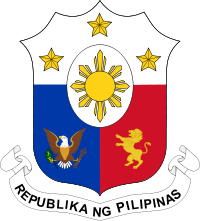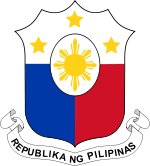- Coat of arms of the Philippines
-
Coat of Arms of the Philippines 
Versions 
Version passed by the Congress in 1998. It must be approved by a referendum before becoming officialDetails Armiger Philippines Adopted July 3, 1946 Escutcheon Paleways of two (2) pieces, azure and gules; a chief argent studded with three (3) mullets equidistant from each other; and, in point of honor, ovoid argent over all the sun rayonnant with eight minor and lesser rays. Motto Republic of the Philippines
Republika ng PilipinasOther elements Bald Eagle of the United States
and Lion-Rampant of Spain (the charge of Kingdom of León)
These elements were not included in Republic Act No. 8491 in 1998, and therefore considered removed, but the change has not been implemented pending ratification by national referendum.Earlier versions With motto: "Isang Bansa, Isang Diwa"
With scroll reading: "Republic of the Philippines"Use Various Philippine Government departments The Coat of Arms of the Philippines features the eight-rayed sun of the Philippines with each ray representing the eight provinces (Batangas, Bulacan, Cavite, Manila, Laguna, Nueva Ecija, Pampanga and Tarlac) which were placed under martial law by Governor-General Ramón Blanco during the Philippine Revolution, and the three five-pointed stars representing the three primary geographic regions of Luzon, Visayas, and Mindanao. In the blue field on the left side is the Eagle of the United States, and in the red field on the right is the Lion-Rampant of Spain, both representing colonial history. It is also used by the Philippine National Bank. The blazon of the coat of arms from Flag and Heraldic Code of the Philippines (Republic Act 8491) is as follows:
...Paleways of two (2) pieces, azure and gules; a chief argent studded with three (3) mullets equidistant from each other; and, in point of honor, ovoid argent over all the sun rayonnant with eight minor and lesser rays. Beneath shall be the scroll with the words "REPUBLIKA NG PILIPINAS," inscribed thereon.[1]History
The Philippine heraldic symbol begin when King Philip II of Spain authorize the first coat of arms to City of Manila through the royal decree issued on March 20, 1596 is as follows:
...a shield will have in the center of its upper part a golden castle on the red field, closed by a blue door and windows, and shall be surmounted by a crown; and in the lower half on the blue field a half lion and a half dolphin of silver, armed and languid gules - that is to say, with red nails and tongue, the said lion shall hold in his paw sword with guard and hilt Coat of arms of the Spanish East Indies (1565–1899).
Coat of arms of the Spanish East Indies (1565–1899).
Eventually the seal evolved and changes some details and features, but the principal devices remained unaltered. The new design was patterned after the national standard of Spain, the seal consist of fleur-de-lis surrounded by quartered flag of Castille and Aragon represented by thwo golden castles located on the red field and two red lions on a white field. The seal was later adopted by Spanish colonial government.
During Philippine Revolution in 1896, the Filipino leaders had no permanent political symbol, however two different coat of arms was easily adopted by the Filipinos, both arms consist of an equilateral triangle, but differs on symbols found inside the triangle. many documents of Katipunan bore a letter K which stand for Kalayaan (Liberty), while some had the rising mythological sun in the center. General Emilio Aguinaldo adopted the mythological sun and five pointed stars in each angle of the equilateral triangle as their coat of arms.
During American occupation, a law was enacted prescribing the new coat of arms for the Philippines . At this time, the Manila coat of arms adopted by Spanish colonial government was still in use until 1905 when Philippine Commission adopted the "new arms and great seal of the Philippine Islands" designed by Gaillard Hunt of the US State Department. It consist of 13 alternating red and white stripes representing 13 original colonies of America; a chief blue above, the honor color, and over them in an oval the arms of Manila with the castle of Spain and the sea lion prominently displayed it also consist of a American eagle, the symbol of United States. beneath the shieldwas the scroll with the words Philippine Islands. It remained unaltered until the inauguration of Commonwealth of the Philippines in 1935.
During Commonwealth Era, extensive reform was mad to the government in preparation for Philippine independence. One of major changes is changing symbol for Filipinos. "The Arms and Great seal of the Commonwealth Government of the Philippines" was approved in 1935, the number of stripes reduce from thirteen to two and three five-pointed stars were added. The eagle was slightly enlarge and place closer to the arm. the word Commonwealth of the Philippines replaced Philippine Islands in the scroll below, it also incorporated the modified seal of City of Manila.
On December 15, 1938, President Manuel Quezon created the Special Committee of Arms of the Philippines. After almost two years of studying, The committee recommend certain modifications to the coat of arms of the Commonwealth of the Philippines. They recommend that the eight ray Philippine sun must be the point of honor. It was revised in 1940, It featured two stripes, blue on the right side while red on the left side of the shield; a chief white field above, studded with tree five-pointed stars equidistant from each other, over them, the eight-ray sun in rayonant with each ray flanked on the both sides of minor rays inside an oval. On the crest is the American eagle, her talon grasping an olive branch with eight leaves and eight fruits, and the left talon grasping three spears, beneath the shield is the scroll with inscription Philippines
Following the providing appropriate symbols to various branches of the government. President Quezon created the Philippine Heraldic Committee in 1940. The committee was assigned the studying and recommending the designs and symbolism for official seals of Philippines' political subdivision, cities and government institutions. The heraldic work of the committee was suspended during Pacific War.
during the Second Philippine Republic, a more nationalistic policy were adopted, the seal was revised, Foreign components of the Filipino heraldic symbol which previously representing its colonial links to Spain and United States were removed, Instead salient features of the falg and seal of short-lived Philippine Republic were incorporated, which consist of the eight-ray mythological sun and three stars located beneath the equilateral triangle. Written within three sets of two marginal lines of the tree sides of the triangle were Kalayaan, Kapayapaan, Katarungan (Liberty, Peace, Justice). Around the seal was a double marginal circle within which was written Republika ng Pilipinas (Republic of the Philippines)
 Arms of the Commonwealth of the Philippines (1939-1946).
Arms of the Commonwealth of the Philippines (1939-1946).
After the World War II, President Sergio Osmena reactivate the Philippine Heraldic Committee. the new design pursuant to Commonwealth Act No. 731 was approved by the Congress of the Philippines on July 3, 1946, It was designed by Captain Galo B. Ocampo, secretary of the Philippine Heraldry Committeeit consist of the Philippine Sun with eight rays, occupies the point of honor in the center, while three five-pointed stars, representing Luzon, Visayas and Mindanao, occupy the upper portion of the field. On the right side, on the blue field is the bald-headed American eagle and on the left side, on the red field, the lion rampant of Spain, beneath the arms is scroll inscribed with the words Republic of the Philippines
During Marcos administration, The Isang Bansa, Isang Diwa (One Nation, One Spirit) become the national motto of the Philippines. It was immediately incorporated in to the national seal replacing the words Republic of the Philippines which were originally inscribed in a scroll beneath the arms, it was approved by the Office of the President on July 31, 1978. The revision of the national seal is due to belief of President Marcos that under his government New Society Program, the ultimate unity of the Filipinos could be achieved through the active participation of every citizen motivated by one guiding spirit. When President Corazon Aquino took over the government. She obliterate any Marcos contribution to the Philippine History. The Philippine coat of arms was reverted, removing the national motto pursuant to Republic Act No. 8491 approved on February 12, 1998. The original design has been followed until now.[2]
References
External links
National symbols of the Philippines Official Unofficial National heroes: José Rizal, Andrés Bonifacio, Emilio Aguinaldo, Apolinario Mabini, Marcelo H. del Pilar, Sultan Dipatuan Kudarat, Juan Luna, Melchora Aquino, and Gabriela Silang · Cariñosa · Carabao · Bangus · "Bayan Ko" · "Pilipinas Kong Mahal" · Juan de la Cruz · Anahaw · Mango · Sipa · Barong and Baro't sayaNational emblems and coats of arms of Asia Sovereign
states- Afghanistan
- Armenia
- Azerbaijan
- Bahrain
- Bangladesh
- Bhutan
- Brunei
- Burma (Myanmar)
- Cambodia
- People's Republic of China
- Cyprus
- East Timor (Timor-Leste)
- Egypt
- Georgia
- India
- Indonesia
- Iran
- Iraq
- Israel
- Japan
- Jordan
- Kazakhstan
- North Korea
- South Korea
- Kuwait
- Kyrgyzstan
- Laos
- Lebanon
- Malaysia
- Maldives
- Mongolia
- Nepal
- Oman
- Pakistan
- Philippines
- Qatar
- Russia
- Saudi Arabia
- Singapore
- Sri Lanka
- Syria
- Tajikistan
- Thailand
- Turkey
- Turkmenistan
- United Arab Emirates
- Uzbekistan
- Vietnam
- Yemen

States with limited
recognition- Abkhazia
- Nagorno-Karabakh
- Northern Cyprus
- Palestine
- Republic of China (Taiwan)
- South Ossetia
Dependencies and
other territoriesCategories:- National symbols of the Philippines
- National coats of arms
Wikimedia Foundation. 2010.

